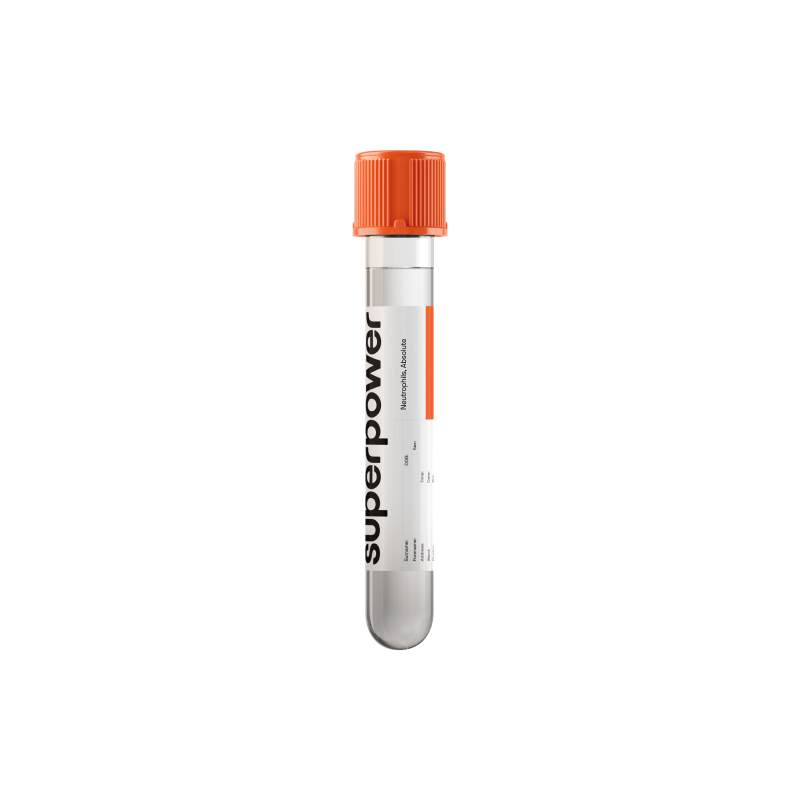Neutrophils are the most abundant white blood cells in circulation. They rapidly move to sites of injury or invasion, engulf microbes, release antimicrobial enzymes, and form extracellular traps to contain infection. The Absolute Neutrophil Count (ANC) is the number of neutrophils per microliter of blood, calculated from a Complete Blood Count (CBC) with differential.
Key Benefits
- See how strong your front-line infection fighters are with absolute neutrophil count.
- Spot possible bacterial infection or acute stress when counts rise above your baseline.
- Flag neutropenia and estimate infection risk: <1000 moderate, <500 severe.
- Clarify recurrent fevers, mouth ulcers, or sore throats by confirming low neutrophil reserves.
- Guide urgent decisions: fever with low ANC needs same-day medical care.
- Guide treatments and medication safety: chemotherapy, immunosuppressants, clozapine, steroid or lithium effects.
- Avoid unnecessary alarm by recognizing benign ethnic neutropenia patterns in some ancestries.
- Best interpreted with a complete blood count differential and your current symptoms.
What is Neutrophils, Absolute?
Neutrophils, Absolute is the total number of neutrophils circulating in your blood at a given moment, often called the absolute neutrophil count (ANC). Neutrophils are the most common type of white blood cell (granulocytes), born in the bone marrow from blood-forming stem cells (myeloid lineage) through a process called granulopoiesis. Once mature, they are released into the bloodstream, where they circulate briefly before moving into tissues. They are short-lived, fast-turnover cells designed for rapid deployment.
Neutrophils are the body’s first responders in the innate immune system, especially against bacteria and fungi. They home to trouble spots (chemotaxis), engulf and digest microbes (phagocytosis), and release microbe-killing enzymes and oxidants (degranulation and respiratory burst). They can also cast web-like DNA nets to trap pathogens (neutrophil extracellular traps, NETs). The absolute count reflects how many of these defenders are immediately available in the blood, capturing the balance between bone marrow production and release versus use and clearance in tissues. In this way, the ANC offers a practical snapshot of front-line immune readiness.
Why is Neutrophils, Absolute important?
Absolute neutrophils (ANC) tell you how many front-line infection fighters are circulating and ready to respond. Because neutrophils are produced in the bone marrow and surge with stress and inflammation, this number reflects immune readiness, marrow health, and whole‑body inflammatory load.
Most adult reference ranges run roughly 1.5–7. For most people, an optimal ANC tends to sit in the middle of that range: high enough to defend, low enough to signal calm inflammation. Children naturally have age‑specific norms (infants and young kids may run differently), and pregnancy often brings a physiologic rise.
When the count is low (neutropenia), the marrow isn’t supplying enough cells or they’re being consumed or redistributed. Below about 1.0, risk of bacterial infections climbs; below about 0.5, even everyday microbes can cause serious illness. People may notice fevers without a clear source, mouth ulcers, gum disease, skin infections, or recurrent sinus and lung infections. In children, temporary dips after viral illnesses are common. Some individuals—especially of African or Middle Eastern ancestry—have chronically lower counts without higher infection risk.
When the count is high, the body is signaling active inflammation: acute bacterial infection, tissue injury, surgery, vigorous exercise, smoking, corticosteroids, and late pregnancy can all drive neutrophilia. Symptoms mirror the trigger—fever, redness and swelling, chest or abdominal pain, or respiratory symptoms. Persistently high counts can indicate ongoing inflammatory or marrow-driven conditions.
Big picture: ANC links the innate immune system with marrow output, hormones, and vascular health. Patterns over time, alongside other markers (total white cells, lymphocytes, CRP), help map infection risk, inflammatory burden, recovery from illness, and long‑term cardiometabolic risk.
What Insights Will I Get?
What Neutrophils, Absolute tells you
This measures the number of neutrophils circulating in your blood. Neutrophils are the frontline cells of innate immunity that rapidly contain bacteria and clean up tissue damage. At a systems level, this reflects bone marrow output, inflammatory tone, and short-term stress responses, all of which influence recovery from infections, energy during illness, and overall resilience.
Low values usually reflect reduced production in the bone marrow or increased use/destruction. Common causes include recent viral illness, autoimmune neutropenia, medication effects, and less often nutrient deficits or congenital conditions. Systemically, this means a higher risk of bacterial infections, mouth ulcers, and fevers. Some people—particularly of African, Middle Eastern, or West Indian ancestry—can have a stable, lower baseline (benign ethnic neutropenia) without increased infection risk.
Being in range suggests a balanced innate immune response with adequate marrow reserve and controlled inflammation. In most adults, optimal tends to sit in the middle of the reference range. For individuals with a lifelong lower baseline and no infection history, a low-normal value may be typical.
High values usually reflect acute inflammation or physiologic stress. Bacterial infections, trauma, surgery, heart attack, or burns can drive a rise. Stress hormones, vigorous exercise, and corticosteroid medicines mobilize neutrophils into the bloodstream. Chronic inflammatory conditions and smoking can also elevate counts. Pregnancy commonly produces a mild increase.
Notes: Neutrophils vary by time of day, recent illness, and stress. Pregnancy, age, ethnicity, and medications (for example, steroids increase; certain chemotherapy decreases; lithium can increase) influence interpretation. Reference intervals differ by lab and population, so context and trends over time matter.



.svg)



.png)
.png)
.png)
.png)








